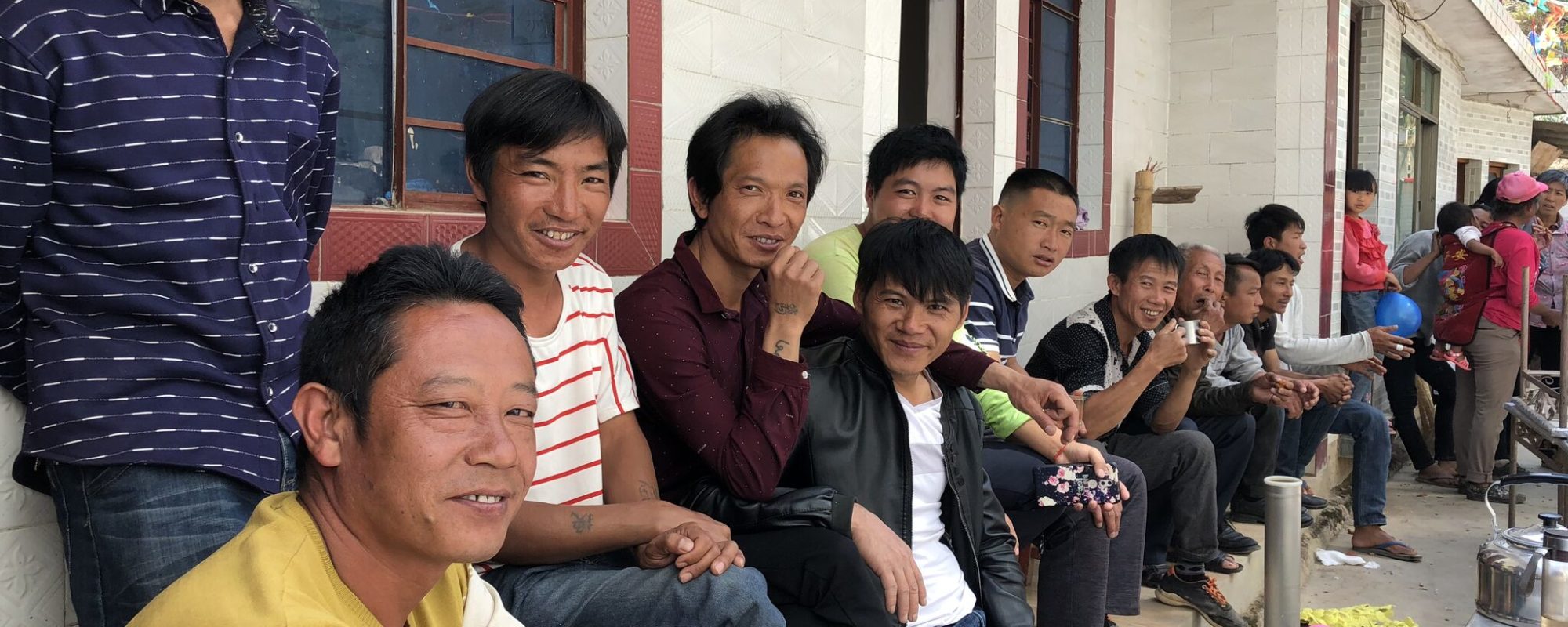BANGDONG, China — The blood gushed out with each squeal, dark like vintage Burgundy. Each labored breath cut off the flow, like pinching a hose, until a new squeal—piercing and terrifying—opened the floodgates anew. It spilled into an aluminum bowl, turning a bright red, like frothy cooling Jello.
That’s not what I was expecting, although I suppose it should have been. I was attending a village shazhu fan, or “pig-slaughtering feast,” for Chinese New Year. It was an educational moment for me and a wide-eyed three-year-old next to me. Moments earlier, the boy’s father, Li Rugui (lee roo-GWAY)—a local tea farmer and the host of our feast—had led the doomed animal from its concrete pen next to their home. Li Rugui was joined by three buddies, with one man holding each ear and two at the tail. The pig made its discomfort clear.
Four more men quickly flanked the animal and flopped it on the ground, each restraining a leg. Li Rugui wrapped a rope around its mouth, holding it shut tight as his butcher friend plunged a six-inch blade into its throat.
The blood flowed.
As it began to congeal, Li Rugui scooped out a fingerful, dropping it into his mouth and smiling at me, gesturing for me to try. I politely declined.
The slaughtering of the second pig went like the first.
Our feast had all the elements of a successful Chinese New Year celebration. Very fresh meat—and lots of it. Card games of “scoop pickled vegetables” (捞腌菜)—a sort of three-card Blackjack—that lasted all afternoon. And home-brewed corn liquor called baijiu that flowed well past midnight. The entire community of this tiny village was in attendance, from young children learning where meat comes from to members of China’s lost generation who easily remember having no meat at all. Tea farmers, construction workers, Party officials, teachers, mothers—everyone made an appearance. Everyone, that is, except one conspicuously absent demographic: returning migrant workers.
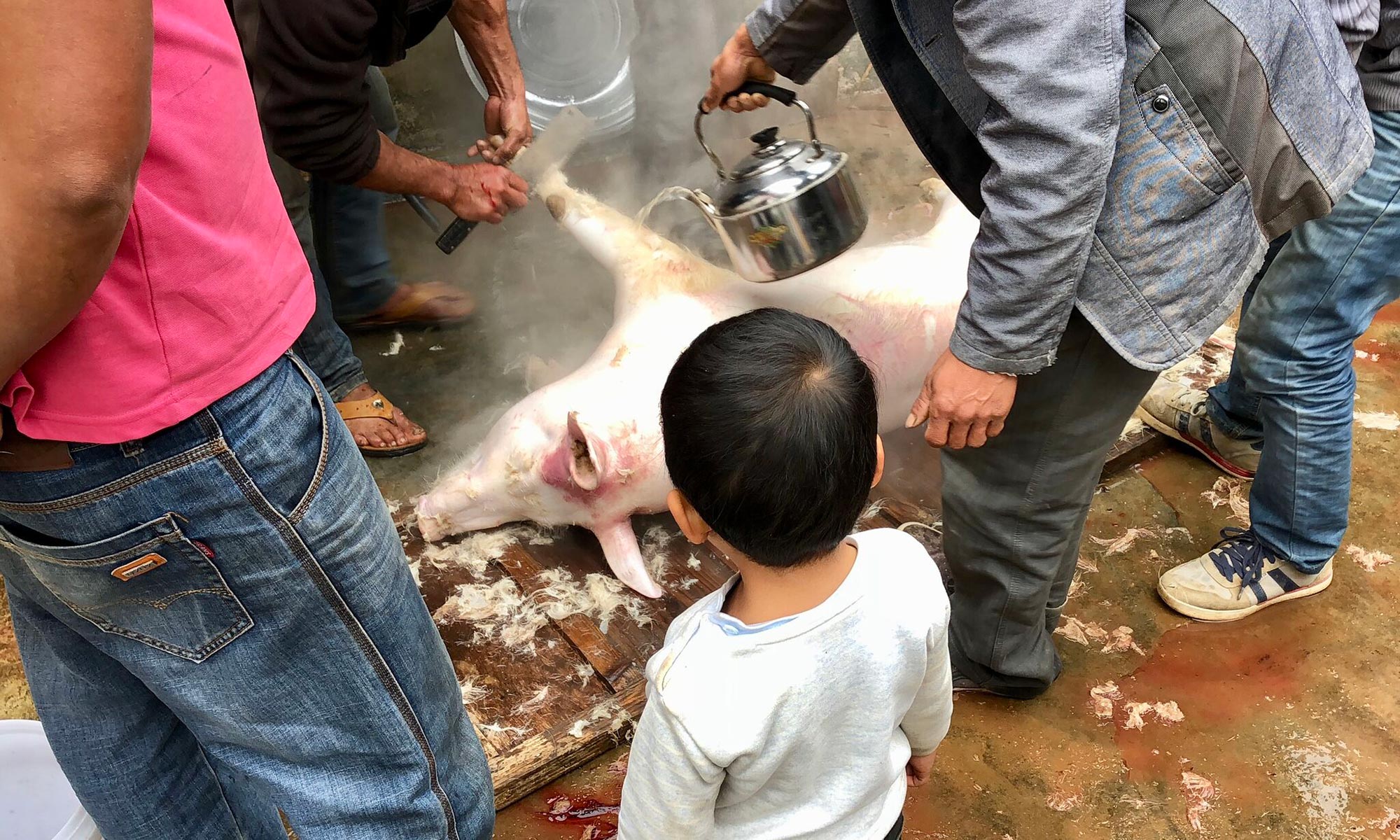
Chunyun, the phenomenon of workers and students returning to their hometowns for Chinese New Year, is widely reported to be the largest migration in human history. Indeed, between the visiting of hometowns and spouses’ parents or vacationing, the Ministry of Transport expected almost three billion trips to be made over the 40 days spanning Chinese New Year. That’s the equivalent of the populations of Africa, Europe and the Americas all boarding planes, trains and automobiles. Of those, almost 290 million travelers are migrant workers who venture into bigger cities during the year to find jobs at construction sites, in factories or anywhere else available. For many, Chinese New Year presents the only chance to return home to see aging parents or even reunite with their own children who are often left behind with grandparents.
But in Bangdong, a settlement of 350 people in rural southwest China, migrant workers were largely absent from the celebrations. It’s not that they didn’t come back to the village, it’s that they never left. As I would find out, it wasn’t always so. Just 10 years ago, “going out” (出去) to work was still the norm. Whether because of economic necessity, youthful curiosity or both, most if not all Bangdong’s young people would join the migrant workforce. But not anymore. Economic growth and a national strategy for rural revitalization are well at work here, transforming the very way and quality of life.
A migrant’s life for me
Li Rugui is an unlikely economics teacher. Solidly built from years of manual labor, he is an intimidating figure. A scar stretches from his left eyebrow down to his jawbone, the only remaining evidence of a drunken motorcycle accident and 200 stitches. On his left forearm, the characters for Bruce Lee (李小龙) are scrawled in fading blue— alcohol-induced and self-inflicted.
In 1992, Li Rugui quit 8th grade in order to help support his family. After several years of building dirt roads and logging in the region with his father for $1 per day, he heard about opportunities across the border in neighboring Myanmar. With an eye for adventure, he joined the ranks of the migrant workforce and headed west along with a village buddy.
The opportunity, as it turned out, was opium. Part of the notorious Golden Triangle, Myanmar was producing most of the world’s heroin, a derivative of opium, in the mid-90s. Although Li Rugui had no work documents, both border and drug enforcement were lax at the time. “On one side of the road you’re in China,” he said. “Walk across and you’re in Myanmar standing in the middle of poppy fields.” He and his buddy worked their first year scoring poppy pods and extracting the dried gum for opium production.
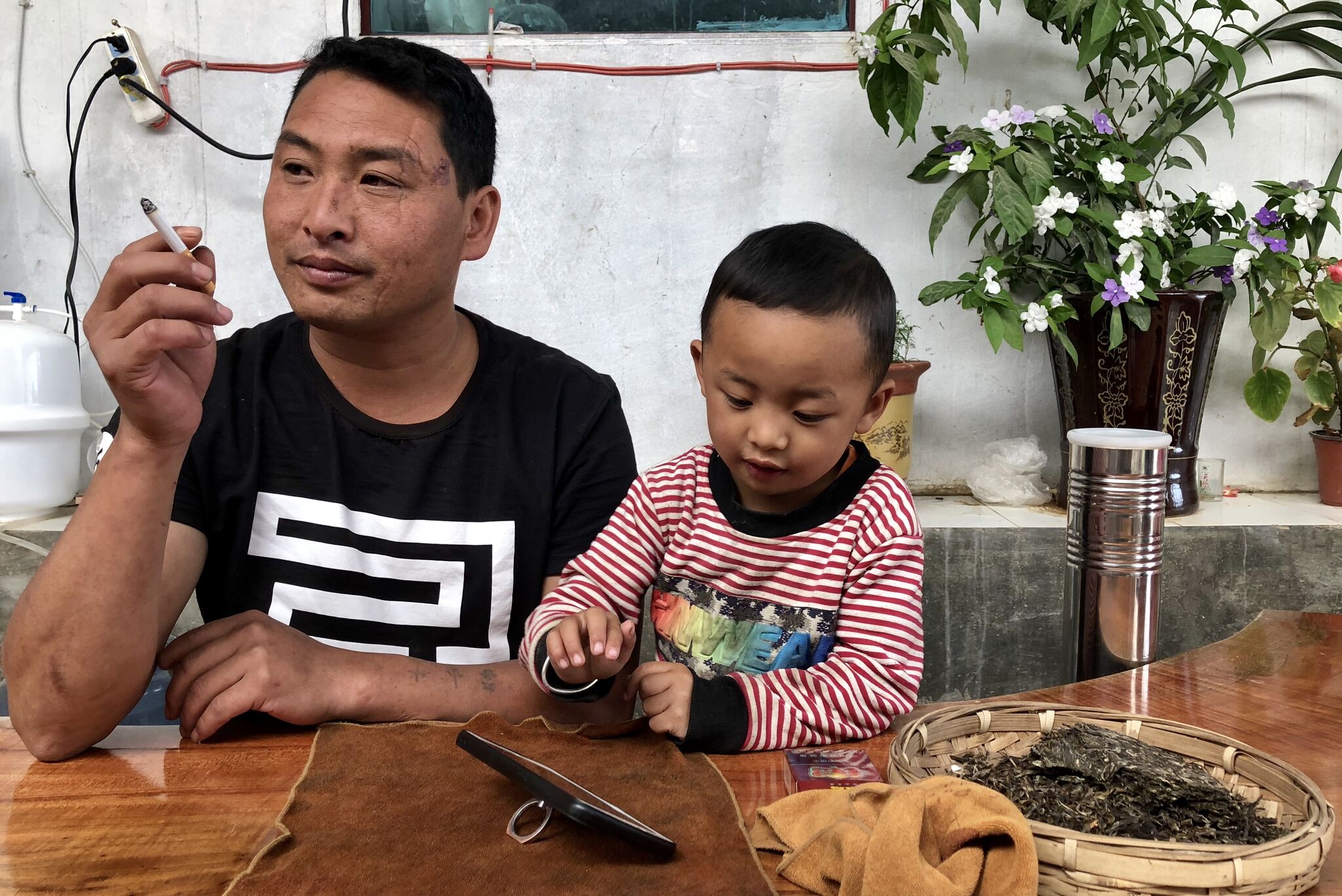
But Li Rugui did not enjoy the work and saw a better opportunity in construction. Returning home for Chinese New Year, he convinced his father to travel to Myanmar with him and his buddy. Together, they worked for two years developing construction projects for local Burmese. However, things did not end well for any of them in Myanmar.
A resurgence of civil war in 2001 wreaked havoc on the country and as Li Rugui and his father rushed back to safety in China, their Burmese bosses refused to settle their debts. Father and son returned from their two years of labor empty-handed. However, they fared better than Li Rugui’s buddy, who had become hooked on opium—the beginning of a vicious cycle that would tragically end with his death.
Father and son returned to what they knew—manual labor in the Bangdong region—making around $2 for a very long day. But soon the allure of money and adventure in the big city captivated Li Rugui. “The only way to get a job in the big city is through connections,” he explained to me. So when he heard of some locals heading to Beijing after Chinese New Year, he decided to throw in his lot with them.
Although some still see rural villages as “backward,” for many in the countryside, a better-quality life revolves around their community at home.
As Li Rugui recounted his story, his voice hinted at the excitement of those days, the sense of independence and self-discovery. We sat outside at a massive table constructed from a solid cross-section of a tree trunk—something suitable for a Last Supper portrait. He brewed tea from his 2017 spring crop, which we sipped from delicate celadon tea cups the size of small chicken eggs, clearly no threat to his masculinity.
Each of the next six years, Li Rugui worked construction in Beijing, joining the chunyun to Bangdong for Chinese New Year. With him came any savings, which he would spend on housing renovations for his parents, blowing the rest on eating, drinking and giving out hongbaos, or red envelopes filled with money, that were a measure of status within the community. During that time, he became an expert in reinforced concrete construction in office buildings and worked on the China World Trade Center and the National Tennis Center for the 2008 Olympics. During his last years “going out,” he would recruit and manage Bangdong work teams on his construction projects and pull in almost $20,000 for the year—an astronomical sum in Bangdong at the time.
However, although the money was good, Li Rugui was eager to find a different way of life. “Chuqu taiku,” (出去太苦) he said in pithy Chinese. “Migrant labor is bitter work.” Moreover, he was now married with a daughter, so he wanted to be home. Bangdong teaconomics finally made that possible.
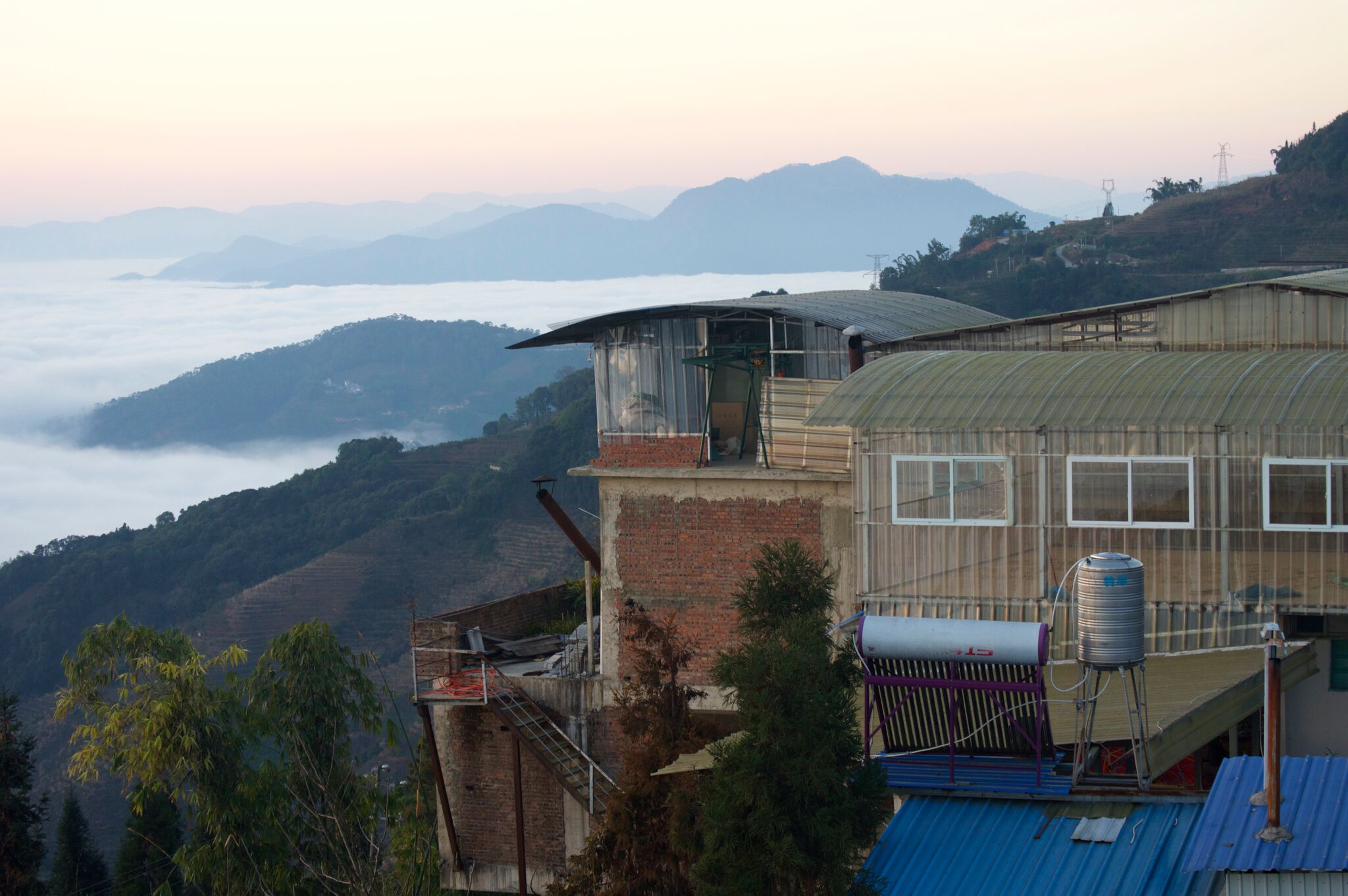
Teaconomics
China’s increasing expendable incomes have led to increasing, often irrational, tea prices. Chinese tea connoisseurs can differentiate between types, regions, years and even seasonal harvests. Similar to fine wines and aged whiskies, some teas are said to improve with time, so collectors have begun to stock up, some to enjoy, some to invest and some to egregiously display their wealth, paying as much as $50,000 for a single kilogram.
But for most in China, regardless of socioeconomic class, tea remains a routine rather than an investment vehicle. Much like the daily Starbucks might be included in a typical American consumer’s basket of goods, tea is a Chinese staple. Demand is high and growing, and increasingly sophisticated markets are responding. Just 10 years ago, your average Bangdong tea sold for $5 per kilogram. Today, the going price is over $50. And tea experts don’t foresee the market topping out any time soon.
Given the demand, almost every villager in Bangdong has converted all his or her acreage to tea trees within the last three to four years. Not only do they benefit from high tea prices, but they also qualify for government subsidies (around $100 per acre annually) under the Grain for Green Project (退耕还林), a campaign to turn low-yielding farmland back into forests and pasture. That engages virtually the entire Bangdong populace in tea production, with some 90 percent involved in picking while 10 percent engages in processing and sales.
Teaconomics has radically changed livelihoods in Bangdong. Work is suddenly regularly available and at a decent wage ($8-$30 per day depending on season and ability). And because of the increase in local disposable income, when it’s not harvest season, other odd jobs abound. People are renovating homes, building tea-processing structures, opening convenience stores and exploring other ways to invest their newfound wealth.
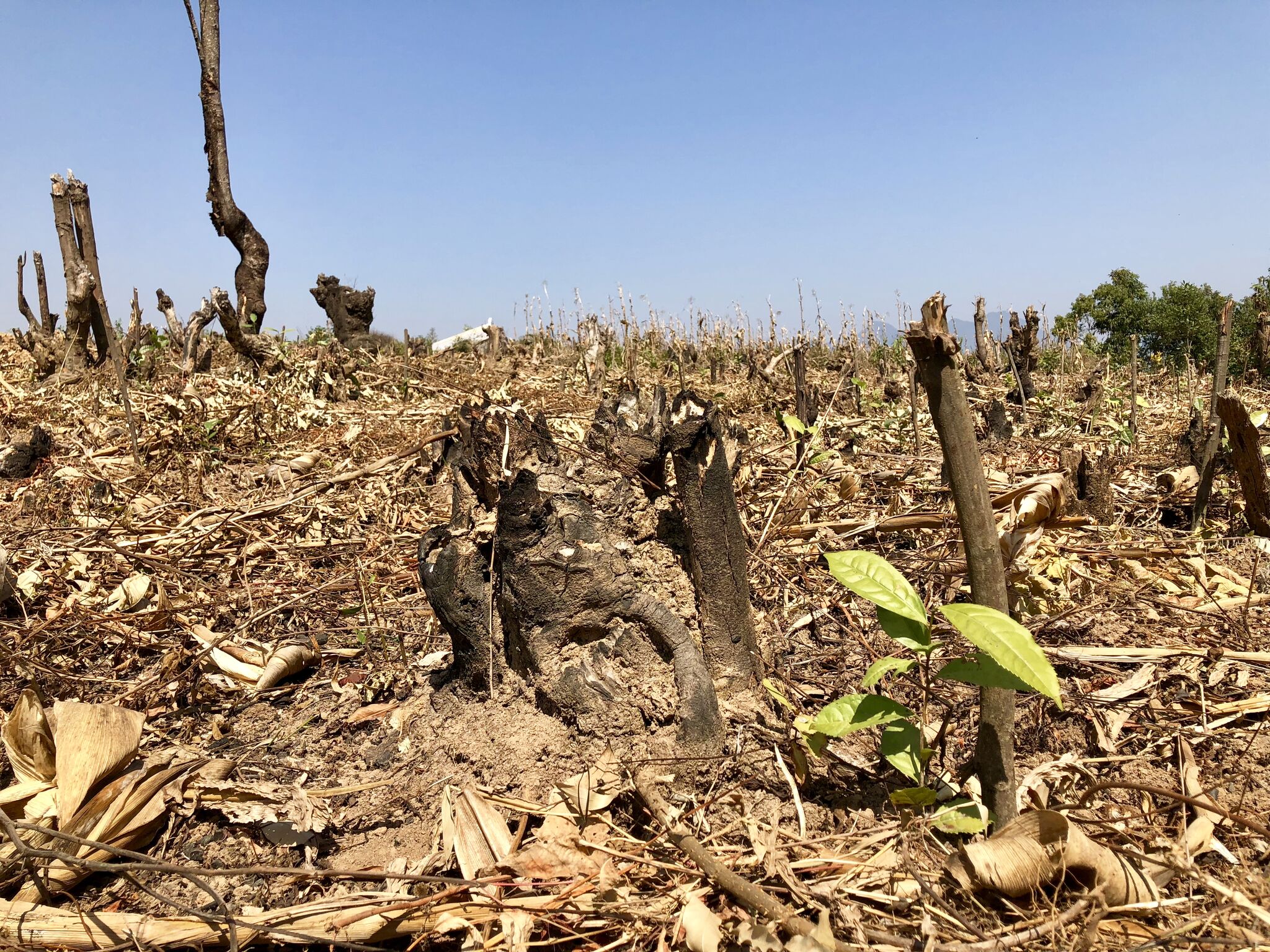
Teaconomics also means Bangdong families can stay together. One young married couple met ten years ago as migrant laborers in northern Yunnan. “Conditions then weren’t like they are now,” the wife said. “I graduated from 9th grade and then had to go out to work. Now, thanks to tea, a girl can stay enrolled through high school, then get married and remain in the village. And there’s work in the village for her husband too, so they don’t need to live apart anymore.” I sensed she was thinking of her two daughters as she spoke. Similarly, Li Rugui can look after his aging parents, his middle schooler need not quit school to help support the family, and his three-year-old has a father figure home throughout the year. Bangdong tea is good for families.
But the benefits come with risks. Are market distortions inflating prices? Are the eager villagers going to flood the market? What if prices crash? One villager confessed he had been unable to find buyers for 10 cases of last year’s tea that were still sitting in his house, supposedly worth about $500 each. “Even with leftovers, though,” he reassured me, “I’ve made more this year on tea than when we grew only corn and rice.”
“But tea won’t fill your belly,” Mayor Zhu Hong told me over one of our fireside chats. “If prices drop to what they were before, for whatever reason, people will be jumping off buildings and drinking pesticide.”
That’s why he’s working on diversifying his portfolio into coffee production and tourism. And he hopes others will watch and follow suit. “I once painted my house bright blue as an experiment,” he recalled. “Pretty soon, many of the houses in the village were blue. I can’t just tell people what to do, but if they see a good idea they’ll copy it. I want to give them a model.” So does the central government, through what’s called rural revitalization.
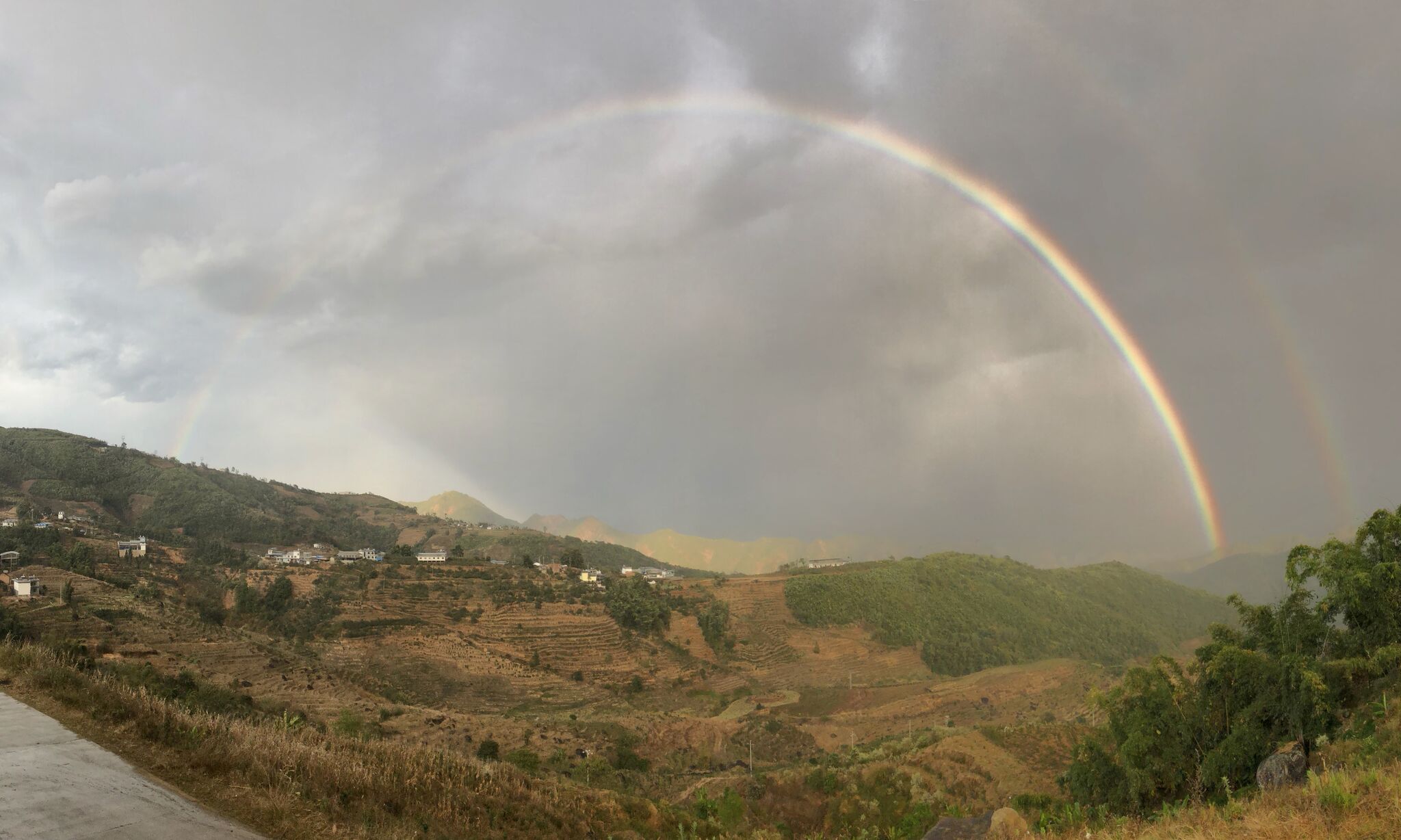
China’s next top model
The alliteratively catchy rural revitalization is here to stay. Just last week at the National People’s Congress, Premier Li Keqiang outlined nine key policy goals for the coming year. Number 5: Making strong moves in the rural revitalization strategy. That is essentially the government echoing the Party’s policy priorities laid out at the 19th Party Congress I wrote about last fall.
Unsurprisingly, rural revitalization is also the focus of last month’s Central Document No.1, so named for being the first policy statement of the year and an indicator of the government’s priorities. Indeed, for the last 15 years, Central Document No.1 has focused on “the three rural issues” (三农)—short-form for agriculture, rural areas and rural residents. As President Xi Jinping elaborated during a panel discussion at the National People’s Congress, “The quality of a moderately prosperous society and socialist modernization is determined by agricultural competitiveness, rural environment, and rural incomes.”
Optimists are quick to praise efforts toward urban-rural equal development while pessimists suggest Party pragmatists are chiefly interested in fending off potential civil unrest. As one official confided to me, “Cities are easy to govern; the few can control the many. It’s the people spread out in the countryside that the Party worries about.” Whatever the motivation, the document calls for poverty elimination by 2020, agricultural modernization and equal access to basic public services by 2035, and strong agriculture, a beautiful countryside and well-off farmers by 2050. It is a lofty undertaking, to be sure, but that’s why it’s a 30-year plan.
Bangdong is already well on its way. For perspective, consider that 30 years ago, each household had only one light bulb, its lumens closer to candlelight than today’s bulbs. Now homes are filled with elaborate light fixtures, washing machines and color televisions. Bangdong has come far in the last three decades and, relatively speaking, does not have far to go to achieve the government’s goals. However, revitalization is not so easy for a place like Jiangjiapu.
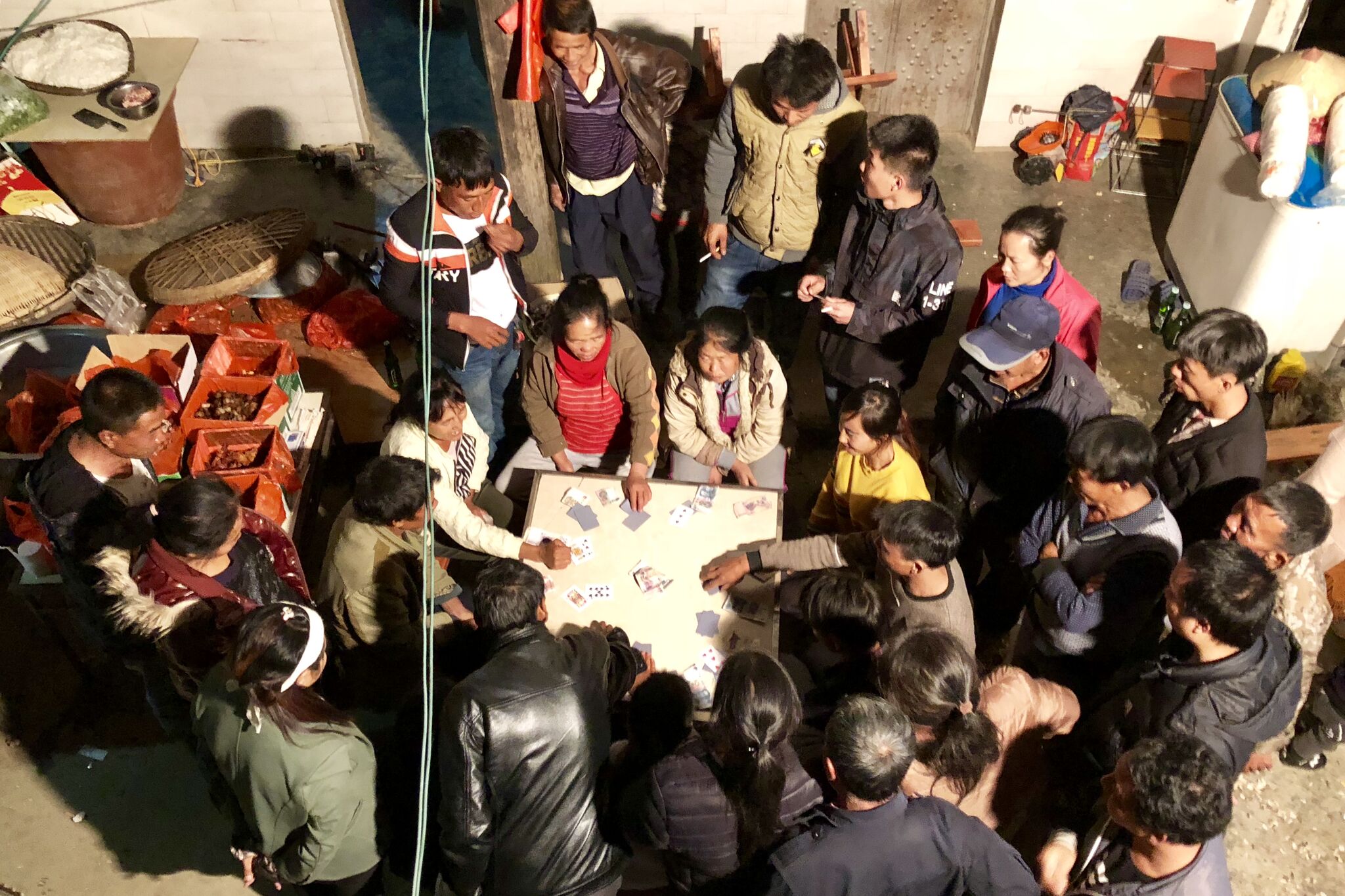
Good conversation about bad tea
There are no road signs to Jiangjiapu. The village sits not far off a single-lane sometimes-paved, sometimes-dirt road that winds the dozen miles from Bangdong. We pass what Zhu Hong calls a “big ugly empty” house—a modern concrete-tile mansion—and turn up an unmarked concrete lane just wide enough for a small car. Winding up the hillside past tea terraces and bamboo groves, we come upon Jiangjiapu, population 200.
Houses are noticeably smaller than in Bangdong—one-story compared to two or three—and, whereas in Bangdong families tend to build on top of their old razed houses, in Jiangjiapu, if families can afford renovations, they incorporate the old mud and wood structures into their renovations.
Today, I’ve come in search of the migrant workers who don’t exist in Bangdong anymore.
Zhu Hong’s cousin, who used to work on construction crews in Shanghai with buddies from this village, let me tag along to pay respects at Chinese New Year. We park on a side road and walk past a crew of men atop bamboo scaffolding. They stop their brick-laying as their curious stares and wide grins follow us up the road. Finally, one extroverted soul howls “Halloooooh?” his tone rising at the end almost as a question. The crew erupts in giggles. I respond with a wave and a warm Chinese-style “Haaalloh,” the guttural “h” starting deep in my throat. I guess foreigners don’t come to Jiangjiapu much.
We visit several friends along the way and eventually stop at Lü Baohong’s house. Given by his grandfather, Baohong’s name means Precious Red, a political reference common in the older man’s generation. The youngest of three brothers, he was also the most expensive. His parents violated China’s family planning restrictions and had to pay a fine of roughly $200, a significant sum in those days. From working in cities, Baohong speaks standard Mandarin, so I no longer have to strain to understand.
“Our tea in Jiangjiapu is not good like Bangdong tea,” he tells me over a fresh steep of his family’s crop. I’m disgusted at my undiscerning palate. The tea tastes great to me.
“It’s colder here and the soil is not as good,” he explains, “so our tea is more bitter and therefore a tenth the price of Bangdong tea.”
The best of Jiangjiapu tea sells for a mere $5 per kilogram compared to $50 or more in Bangdong. “They must have to basically give away their bad stuff,” I think as I look down at my free cup of tea. A large garbage bag of tea slumps in the corner.
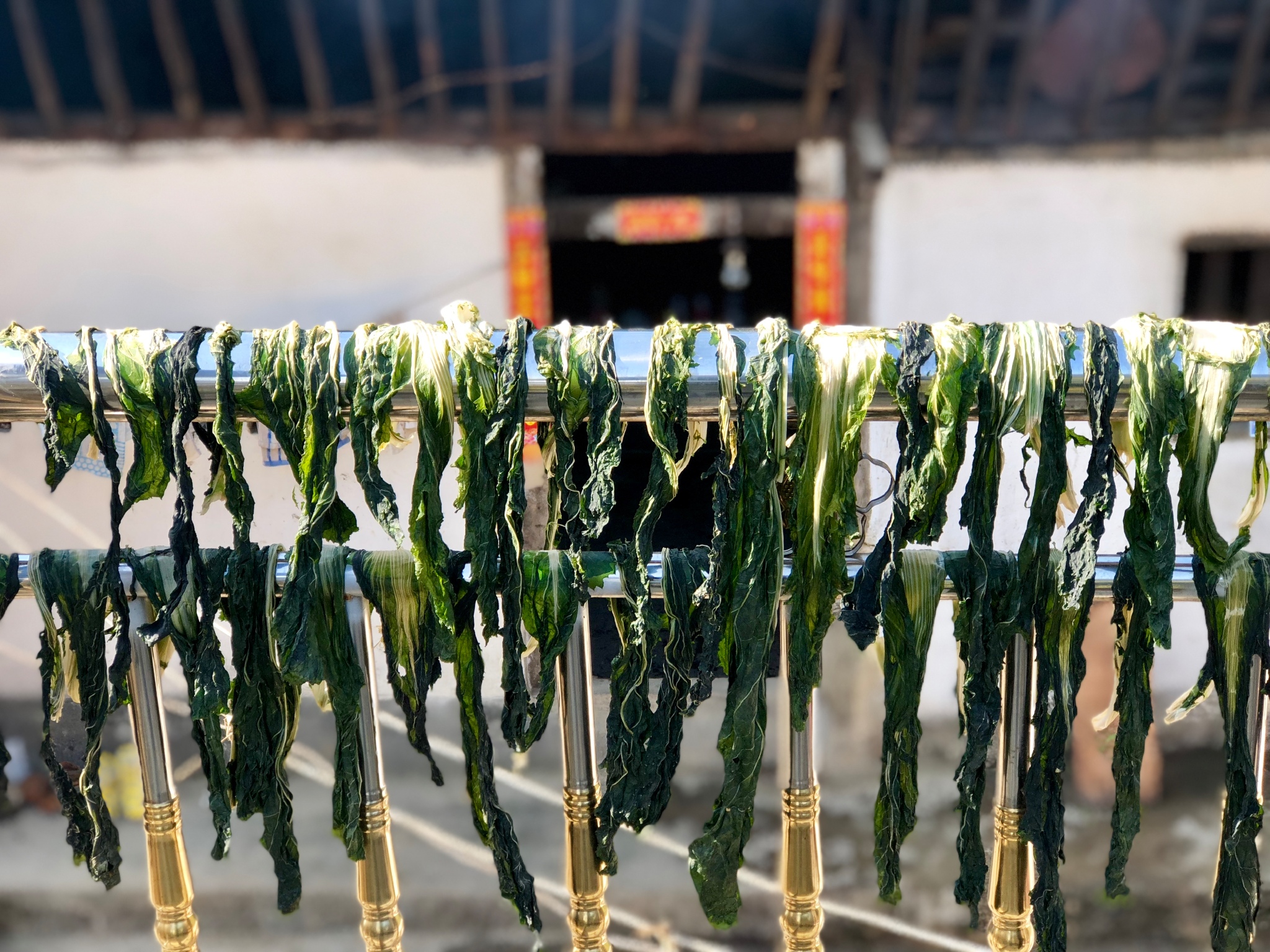
As we chat, his mother returns from the fields with a woven bamboo basket of turnips on her back. His father busies himself in the courtyard chopping up vegetation to feed the livestock. Both are dark brown, their faces weathered by the sun. Baohong continues, talking about employment opportunities in the region: “My parents can still work, so they raise livestock and grow vegetables that we mostly eat ourselves. Our tea and corn aren’t really enough to make a living, so most everyone here who can go out does. I work rebar in Lincang. That’s how I got this,” he says pointing at his bandaged foot. “And my wife works at a cafe in Kunming. Our three-year-old stays with my wife’s parents in Bangdong.”
Baohong speaks quietly and with kindness, but not confidence. He has unkempt hair and a sincere-looking face that seems as if it should smile more than it does. “We would love to come back here to all live together,” he continues. “We plan to. But it’s not easy. There’s no work here. Those guys working construction outside—they won’t be here in a couple weeks. They’ll all go to other cities to find work, too.”
“We are also considering moving to Bangdong to take care of my wife’s parents,” he continues. “There we could grow better tea and probably do pretty well. But it’s not home.”
Desperate yells interrupt our conversation. “Fire! Fire!” Neighbors rush from their homes and look up the hillside where flames are leaping from the top of an old wooden home. We run up a dirt shortcut to where villagers are frantically filling buckets of water from sinks and hoses. I join a trail of villagers running buckets from a neighbor’s well up to the house. But our buckets are slow to fill and the water has little effect on the raging fire.
Suddenly, a burst of flames shoots up from the collapsing roof as a pile of firewood inside ignites. The smoke is thick and the air full of floating ash, like a spring snowfall. Villagers cringe from the heat as they try to get close enough to toss water on the flames. We quickly realize that the structure is a lost cause, so our focus turns to dousing the adjoining concrete home. One young man uses a long wooden pole to knock down the remaining sheets of roofing so they don’t burn as well. Eventually the chaos turns into a crowd as people begin to stand and watch. The remains of the house lie charred and smoking, with nothing left to burn or save.
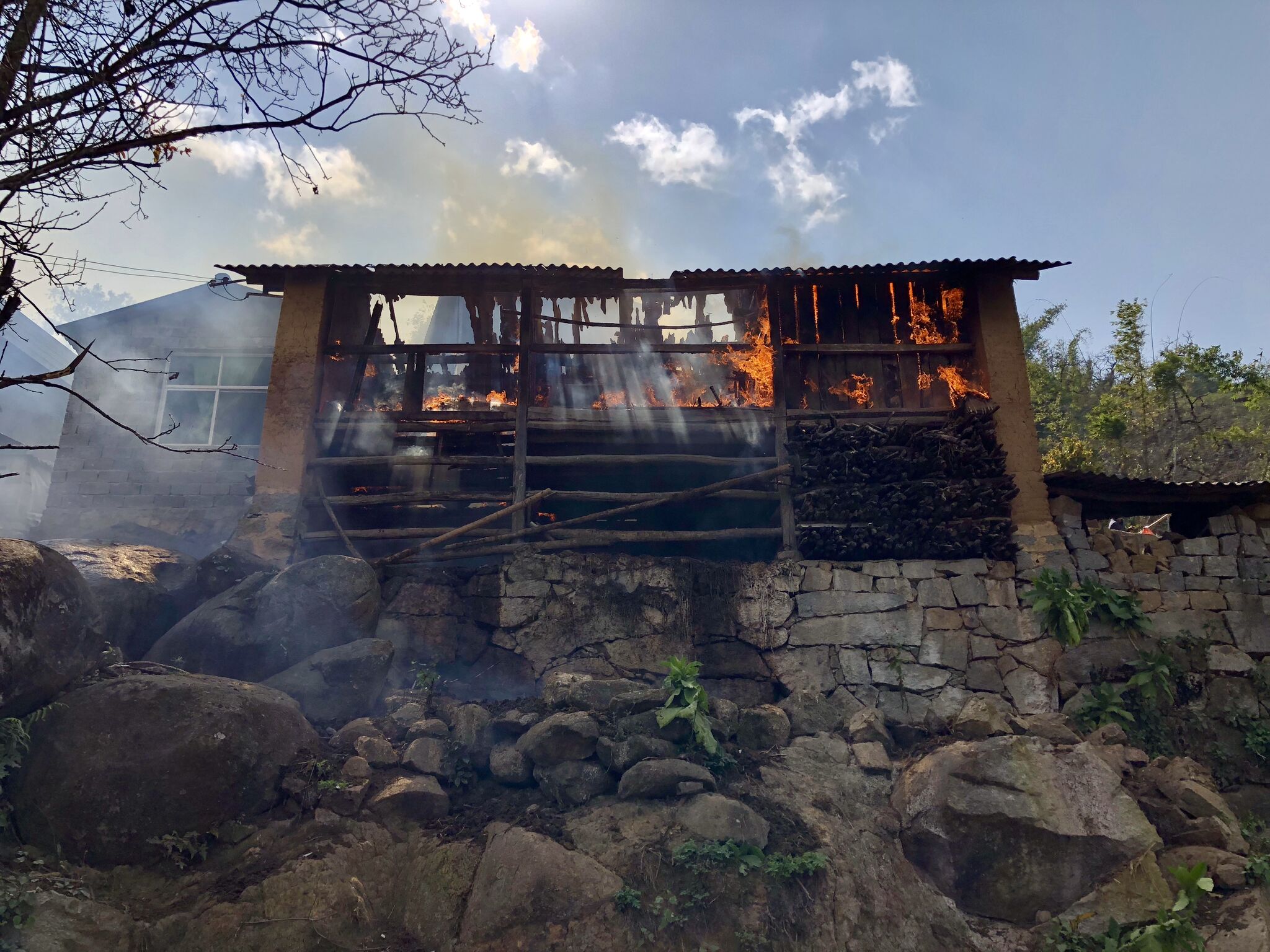
That evening after a meal of fried sausage, kale soup and rice, we squat on short stools and warm ourselves by the fire in Baohong’s kitchen—essentially a concrete box with black, smoke-stained walls. “It was extra-windy today,” Baohong says, speculating about what started the housefire. “They were probably cooking and it got out of control. Thankfully, the house was just used for cooking and storage so no one got hurt. It won’t be cheap to rebuild,” he continues, “Probably $5,000—but they will be fine.”
We sit in darkness except for a single light bulb and the firelight. There’s a long pause before Baohong continues. “Things aren’t easy, but at least it’s not like when I was little.“ Baohong was born in 1988, the auspicious year of the dragon, and grew up when the effects of China’s Reform and Opening were still slow to reach far-flung rural Yunnan.“ All we had was corn to eat and even that we had to share with the animals. Many times, we just went hungry.” I glance at Baohong’s father. His knowing eyes remain silent as he puffs his hand-made bamboo pipe. “Things are not easy here,” Baohong concludes, “but they’re sure better than they used to be.”
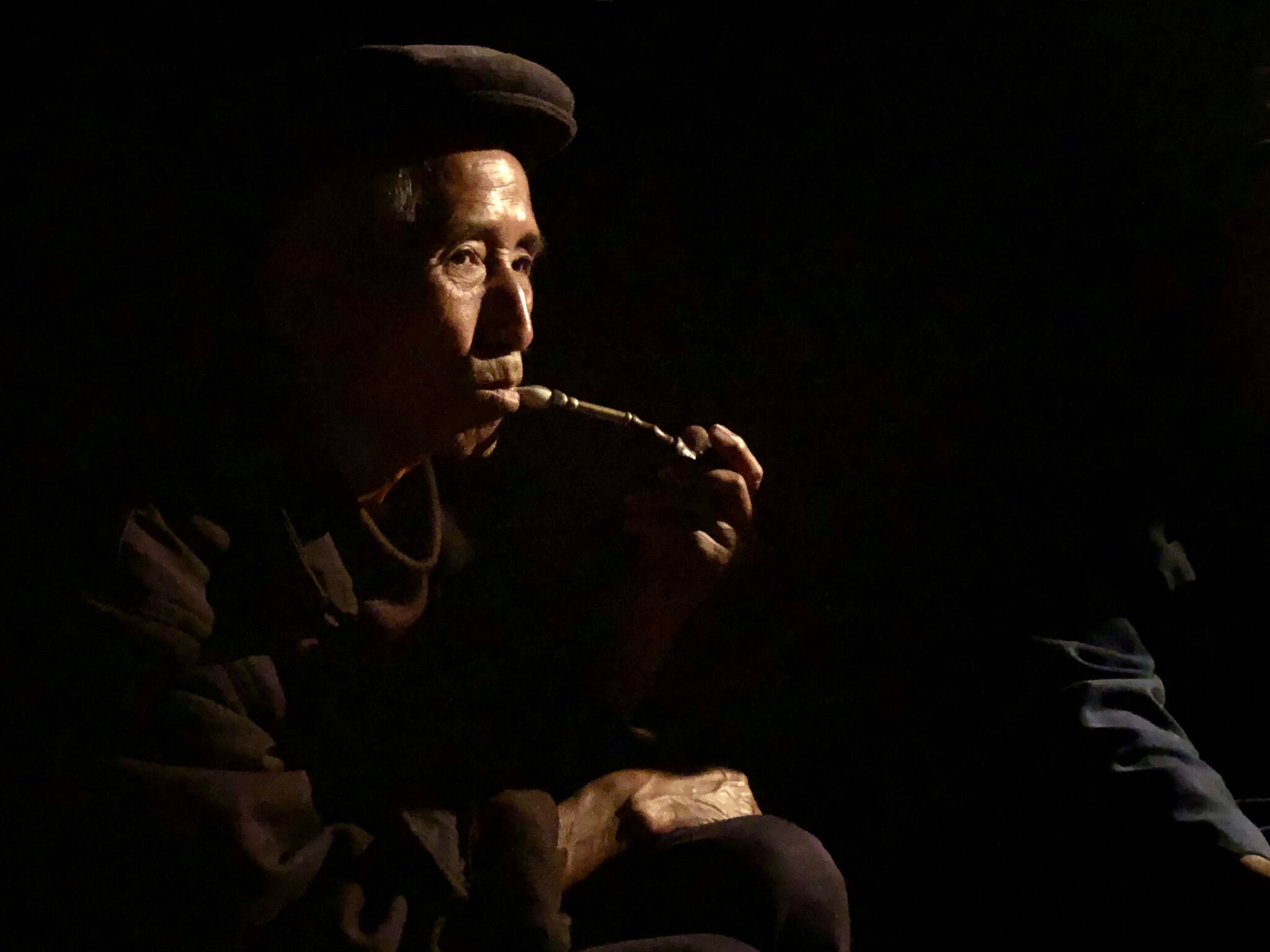
From backward to beautiful
Some places like Jiangjiapu have little going for them—no cash crop and no capital other than what villagers bring back with them bill-by-bill, year-by-year. Revitalization is labor-intensive and slow. And while Bangdong seems to be doing well, it also faces its own challenges. The risk of dropping tea prices remains a stark reality.
At the 19th Party Congress last fall, China officially shifted the focus of its development strategy from high-speed growth to better-quality life, including by addressing unequal development. Moreover, with term limits now abolished, President Xi has the time to see the efforts through to conclusion. Although some still see places like Bangdong and Jiangjiapu as luohou, or “backward,” for many people in the countryside, a better-quality life revolves around their community at home. That means conditions for rural revitalization are ripening both from the top-down and the bottom-up. More places like Jiangjiapu and Bangdong will be slowly shifting along the development spectrum toward “strong agriculture, a beautiful countryside and well-off farmers.”
As the moon began to rise over Li Rugui’s pig-slaughtering feast back in Bangdong, mothers began to pack their sleeping children home strapped to their backs. Fourteen people squeezed around a table to “scoop pickled vegetables” while double that number crowded around providing commentary. Old classmates and their middle school teacher toasted one another with rounds of baijiu. Others squatted around the fire munching on sunflower seeds.
And I get it.
I understand the drive to seek opportunity, even if it’s on the other side of the country or the world. But there truly is no place like home. I understand the importance of being known in a community. I understand the value of having a village with which to raise a child. And I’m no longer curious, but glad that the migrant workers are missing from this feast.
点击查看中文版简报

